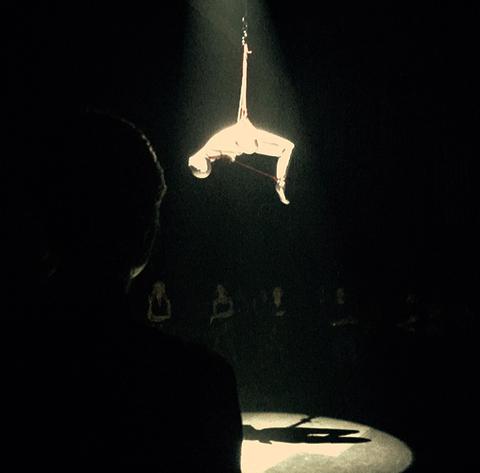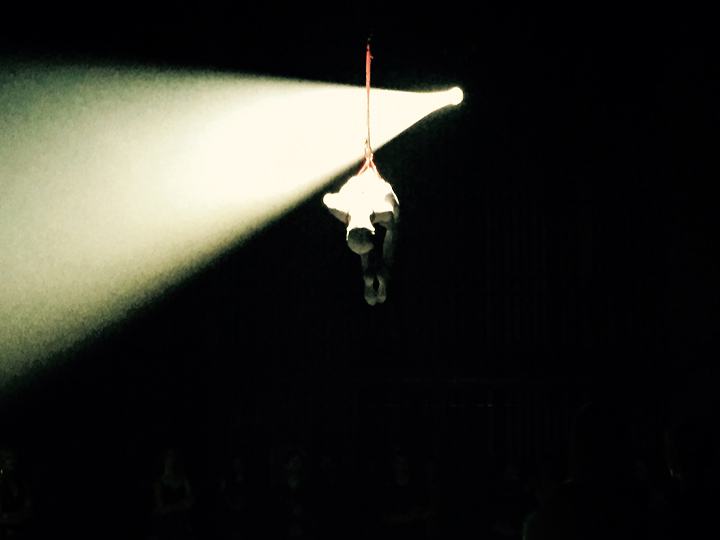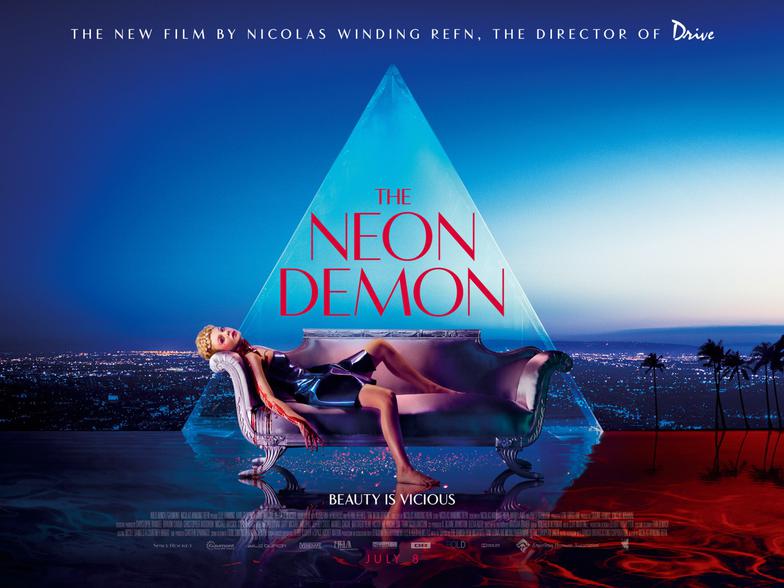Master K Classes
For a Master Class in Kinbaku
Q&A with Master "K": Rigging for "The Neon Demon"
Since the release of the film “The Neon Demon” and the posting of my long, behind the scenes article on my publisher’s website www.thebeautyofkinbaku.com I have received a number of very intelligent questions from friends and readers regarding the film and the Kinbaku I did for it. I thought I would take the opportunity to answer these questions for the followers of the Master “K” Classes website.
Behind the scenes still of the 3 story suspension from the set of "The Neon Demon."
Second, there is a lot of onset discipline that has to be understood. By this I mean, movie sets and fashion shoots can be intimidating places and how you go about doing things and knowing what is your place in the production have to be carefully understood. In a film such as “The Neon Demon” time is of the essence so the work has to be done efficiently and you have to be ready when the director and crew are ready to shoot.
First, doing Kinbaku for yourself is all about exercising your own “rope creativity” for your own interests and the interests, pleasure and safety of your partner. On a film that creativity can still exist but has to be in the service of the person who is paying you or who is creatively in charge of the project.
Well, there are three main reasons.
Why so?
To answer your question, yes, in many way it’s completely different working on a commercial project like “The Neon Demon” then any of the other activities you mention.
Q - Congratulations on doing the film. That’s very exciting but I’m curious as to whether doing the rigging for such a commercial film is that much different from your own pictures, publishing efforts or simply private playing at a club?
A - Well, first off, thank you very much for the compliment. I was honored to be asked to do the film.
Is this type of rigging something you've always been interested in?
Yes, definitely. I’m always interested in presenting Kinbaku in a positive light to the vanilla world so that they can see it for its beauty, artistry and interesting historical traditions, to say nothing of appreciating it for its positive psychological and physical aspects. Therefore, these commercial projects, fashion shoots or movies are very important for “getting the word out” about the beauty of Japanese rope. It’s a different kind of communication through Kinbaku.
Did you study to do this kind of work?
Yes. I was very fortunate to have as one of my sensei the great movie rigger Urado Hiroshi who is responsible for doing most of the wonderful Kinbaku in the Japanese “Pink” (erotic) films for Nikkatsu Studios in the 1970s and 1980s which featured elaborate and creative ties and starred such people as the legendary Naomi Tani in such films as the first “Flower and Snake” and “Wife to be Sacrificed.”
I had many discussions with Urado sensei about his techniques and he taught me a great deal about how to do this kind of tying for movies and another commercial projects.
What kind of things did he teach you?
Well, everything from set etiquette to how to assess a potential model’s suitability for certain kinds of ties that are more efficient to do; as well as more important lessons about safety when dealing with, let’s say, a movie set. One has to remember that unlike a BDSM stage show or in private playing the model often has to remain tied for a very long time. For instance, in “The Neon Demon” “G” was tied for a good hour and a half and suspended 17 times!
Urado sensei is fanatical when it comes to safety and we talked about this a lot. For instance, when I did the “Pendulum” suspension video with the wonderful English performance artist Millie Brown, I had the chance to talk him after the shoot and all he was interested in was knowing what safety measures I had used. I once asked him if he had ever injured anyone on one of his films. He looked surprised and then said, “Never! If I had I could never consider myself a professional.”
Third, as with private play, safety is paramount but in these kinds of commercial shoots one is often working either with actors who have no interest in BDSM or with people who have an interest but who may be, for the most part, inexperienced. Such was the case with the wonderful model “G” who was featured in the three-story suspension done for “The Neon Demon.” She had an interest in Kinbaku but she was not experienced so she had to be approached and tied with a great deal of understanding of her physicality, strengths and weaknesses.
I find them all fascinating to do. And all are different. For instance, in the fashion shoots I did with Michel Comte for GQ Italy which were later published in his art book “Michel Comte and Milk, a 20 Year Collaboration” he had a very good idea of the type of pictures he wanted to create but he wasn’t so certain about the type of rope he wanted to see. Therefore, with him I had to do more on set creating. With the wonderful celebrity photographer Michael Helms, he’s interested in shooting off the cuff, so to speak. That is, he likes me to work with a model and then he’s happy to use his tremendous skill to turn the Kinbaku and model’s natural pose into a wonderful still image. On the other hand, an “auteur” director like Nicolas Winding Refn knows exactly what he wants and in the case of “The Neon Demon” he was extremely specific as to the type of pose, the type of model and even the exact angle he would shoot the scene from. It’s all a question of servicing and working with these marvelous talents. That’s what makes it exciting. That’s what makes it so much fun.
Which do you find most interesting: movies, professional still shoots or advertising?
(Note to readers – there is much more information on Urato Hiroshi, the famous Nikkatsu S&M films, Arisue Go and all his film and TV work and Yukimura Haruki in the newly published, revised edition of Master K’s book, “The Beauty of Kinbaku.”)
And, of course, I can't forget my other great teacher Yukimura Haruki who began his career as a still photographer and taught me so much about finding the right photographic angle for each tie and the most interesting, dramatic or graceful pose for the model. This certainly applies to film as well as still photography. He was a great inspiration in this regard.
Well, in addition to Urado sensei who was so active in the 1970s and 1980s I also admire the film work that Arisue Go has done more recently, whether it’s some of the wonderful Kinbaku he’s done for the various “Flower and Snake” film remakes over the years or his work on the marvelous Japanese TV series “Tokubou” of several seasons ago. Actually, I did a long interview with Arisue sensei about the show which was posted on my publisher’s site if anyone would like to read it. He has some very interesting things to say.
Is there anyone else that you have learned this type of tying from?
These kinds of projects don’t come along that often in the West and I’m very flattered to have been asked to do a number of them in the past few years. Unlike in Japan, where one still sees Kinbaku being used in a number of movies and even TV shows, anything that appears to be BDSM related, such as elaborate styles of bondage, continues to be considered “edgy” in the West and doesn’t show up in mainstream media and advertising that often. However, since the “Fifty Shades of Grey” phenomenon there has been a little more of it being done for the commercial publishing, fashion and entertainment fields by courageous artists and producers.
Do you do this type of thing often?
The other important lessons I learned from Urado-san concerned questions of aesthetics. When doing commercial shoots one always has to remember to be true to what the creative head of the project is going for and to try to use one’s rope skills and one’s materials (like colored rope, types of ties, etc.) in the service of the project.







